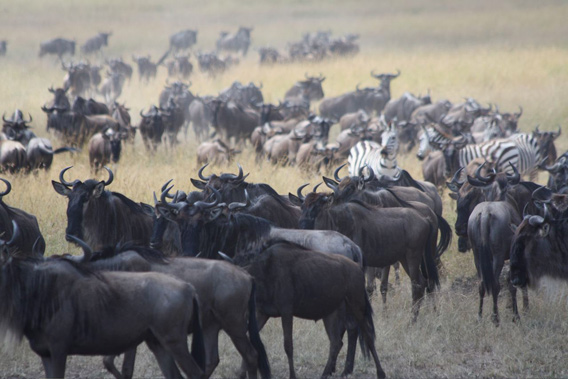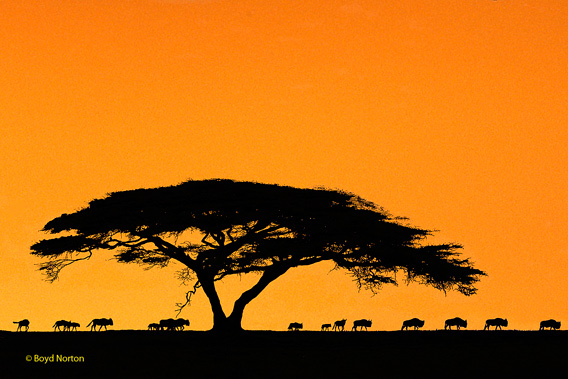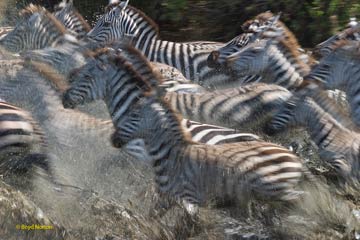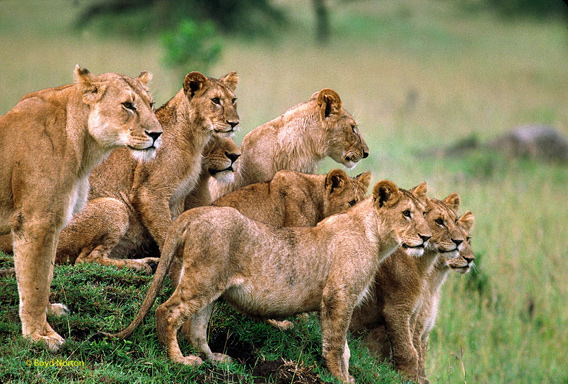
Migrating wildebeest and zebra. Photo by: Jan Martin McGuire.
On March 19th the conservation organization, Serengeti Watch, is planning the world’s first International Serengeti Day to celebrate one of the world’s most treasured wildlife ecosystems. But the day also has another goal: bring attention to a Tanzanian government plan to build a road that would essentially cut the ecosystem, threatening the world’s largest mammal migration.
“The proposed road will be a major commercial route that cuts across a narrow stretch of the Park near the border with Kenya. It goes through a wilderness zone critical to the annual migration of 1.3 million wildebeest and 0.7 million zebras, antelope, and other wildlife. This will involve extracting a strip of land from the Park itself, resulting in both the fragmentation of the ecosystem and the removal of the Serengeti National Park from the list of UN World Heritage Sites,” said David Blanton, co-founder of Serengeti Watch, in an interview with mongabay.com.
Along with the UN, scientists, conservationists, tourists, and even tourism companies, have all decried the plan to build a road that would bisect the northern end of Serengeti National Park. Warnings that the road would end the migration were borne out by a scientific study recently that found the wildebeest population would likely drop by 35%. A leaked government report also found that the road project would ‘limit’ the migration with impacts rippling down to the Serengeti’s big predators. Yet, still the Tanzanian government appears set on building the road—despite an alternative route proposal that would circumvent the park.
“The fact that the president of Tanzania has recently refused funds from the World Bank for a southern route around the Serengeti, which would actually benefit more people, means that there’s something we don’t understand,” Blanton says.
Blanton spoke to mongabay.com about his hopes for International Serengeti Day and why it’s imperative that the Tanzanian people know more about the project.

Serengeti scene. Photo by: Boyd Norton, co-founder of Serengeti Watch.
INTERVIEW WITH DAVID BLANTON
Mongabay: Why does the Serengeti needs it own day of recognition around the world?
David Blanton: The Serengeti ecosystem (the Serengeti National Park and the Masai Mara Reserve in Kenya) is in imminent danger of being lost. A plan by the Tanzanian government will cut a commercial highway through the Serengeti that will bring thousands of trucks a day through a wilderness area critical to the great migration. It will mean the end of the Serengeti as we know it.
Holding a special Serengeti Day will focus world attention to this crisis. It will also help bring the facts to the people of Tanzania, who have not been told the truth about this highway.
Mongabay: What is being planned so far for the day?
David Blanton: Many countries around the world have their own organizers who are coordinating activities and helping to publicize the issue. People will be hosting awareness parties, doing letter and postcard writing campaigns, walking to raise funds and awareness, and even bringing this into the schools with a special curriculum.
Mongabay: The most immediate issue facing the Serengeti is a road plan that would cut the park in half. How will this impact the wildlife?
David Blanton: The proposed road will be a major commercial route that cuts across a narrow stretch of the Park near the border with Kenya. It goes through a wilderness zone critical to the annual migration of 1.3 million wildebeest and 0.7 million zebras, antelope, and other wildlife. This will involve extracting a strip of land from the Park itself, resulting in both the fragmentation of the ecosystem and the removal of the Serengeti National Park from the list of UN World Heritage Sites.
Here are the Tanzanian government’s own estimates – By 2015, there will be 800 vehicles a day, or about 300,000 a year. These will mostly be trucks carrying freight between the Lake Victoria region and eastern Tanzania. Their numbers will steadily grow. By 2016, over a million vehicles will have crossed the Serengeti. By 2035, the volume will rise to 3,000 a day, a million vehicles a year! One expert close to the issue has said, “Those traffic estimates are also believed to be vastly underestimated,” as projections were made on the basis of reduced traffic flow during rainy season.
Tony Sinclair, widely regarded as the world’s foremost expert on the Serengeti, says:
 Serengeti zebras migrating. Photo by: Boyd Norton, co-founder of Serengeti Watch. |
“The soils are largely of silt and cannot take heavy vehicle traffic. Although the road may be initially of murrum or gravel, the increasing flow of vehicles will inevitably lead to a tarmac road. This will result in road kills when as many as one million wildebeest will be settled, not just crossing, along this road… Essentially the Serengeti as we know it will no longer exist. History has shown that once we start this process of road development, there is no turning back on the sequence.”
Experts have recently published a sophisticated model simulating the impact of the highway on the migration. But now with the projected traffic numbers, only common sense is required. The migration will not only move across the highway twice a year, wildlife actually resides in the area for weeks and months on end. Ultimately, though, its not traffic per se, but expanding agriculture and settlement that will unravel it all.
Mongabay: Do you think Tanzania’s tourism industry will benefit from the road?
David Blanton: This road will have a devastating effect on tourism, both in the short term and long term as the ecosystem collapses. A survey was done last year among tourism companies that send travelers to Tanzania. The results were clear – building the highway would cause a precipitous drop in tourism. Why? In part because the Serengeti would be damaged goods, no longer protected and respected by the government. But there would also be a backlash of protest. In fact, many tour companies predicted that there would be a call for an international boycott of tourism to Tanzania.
Mongabay: Why do you think the government is pushing ahead with the road in face of so much criticism?
David Blanton: This is the big question. The fact that the president of Tanzania has recently refused funds from the World Bank for a southern route around the Serengeti, which would actually benefit more people, means that there’s something we don’t understand. It appears that there are interests being served besides those of the Tanzanian people.
Mongabay: How do Tanzanians feel about the road plan?
David Blanton: Many Tanzanians do not know about it. Or if they know anything, they have only heard the government’s version. The president of Tanzania presents this simply as a dirt road, not a highway. And the government has dismissed opponents as “green activists,” even though this includes the UNESCO World Heritage Committee. People certainly do not know what the economic consequences will be, especially for the 60,000 people who directly or indirectly are employed because of tourism. We do know there is a growing opposition, but most are afraid to speak out publicly against their government’s policies.
Mongabay: Even if the road is abandoned, what other threats does the Serengeti face?

Lions in the Serengeti landscape would suffer from prey declines if the road goes forward according to a leaked government report. Photo by: Boyd Norton, co-founder of Serengeti Watch.
David Blanton: The Serengeti faces a multitude of threats.
- The 2010 UNESCO report warned of alarming levels of poaching.
- Lake Natron, to the east of the Serengeti, has repeatedly been targeted for mining. The government wants to go ahead with this as well.
- There are plans on the drawing board, and investors in the wings, for a major international airport right next to the Park. Read more here.
- New tourism development does not have proper planning or limits, especially for water supplies.
- Human pressure continues – the Serengeti is surrounded by a growing population with legitimate needs of their own. They need support.
Mongabay: How can people join in on March 19th to celebrate the Serengeti?
David Blanton: Go to the
Serengeti Day web page for information on how to participate. You can also contact an organizer in your own country. There is information on how to do this on the page. Finally, people can sign up to get more information from Serengeti Watch.

Related articles
Leaked government study: road will damage Serengeti wildlife, despite president’s assurances
(02/10/2011) Tanzania’s President, Jakaya Kikwete, today gave promises that his proposed road project, which will bisect the Serengeti plains, would not hurt one of the world’s most famed parks and one of its last great land migrations. “The Serengeti is a jewel of our nation as well as for the international community. […] We will do nothing to hurt the Serengeti and we would like the international community to know this,” Kikwete said in a statement reported by the AFP. However, a government environment impact study, leaked to the conservation organization Serengeti Watch, paints a very different picture of how the road will damage the Serengeti. The report includes warnings that the road will ‘limit’ the migration of the plains’ 1.5 million wildebeest and 500,000 other herbivores including zebra.
Scientists: road through Serengeti would likely end wildebeest migration
(02/02/2011) A new study finds that a proposed road cutting through Serengeti National Park would likely have devastating consequences for one of the world’s last great migrations. According to the study the road itself could lead to a 35% loss in the famed park’s migrating wildebeest herd, essentially cutting the herd down by over half a million animals. Despite such concerns, and the availability of an alternative route that would bypass the Serengeti plains altogether, the Tanzanian government has stated it is going ahead with the controversial road.
World Bank offers to save Serengeti from bisecting road
(01/31/2011) The World Bank has offered to help fund an alternative route for a planned road project that would otherwise cut through Tanzania’s world famous Serengeti National Park, according to the German-based NGO Nature and Biodiversity Conservation Union (NABU). When announced last year, the road project raised protests from environmentalists, scientists, and Tanzanian tour companies, but the Tanzanian government refused to shift plans to an alternative southern route for the road, thereby bypassing the park.